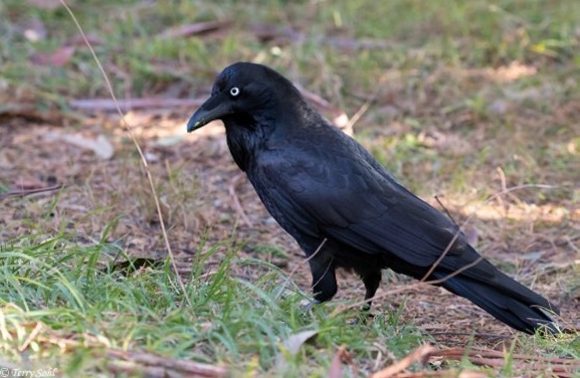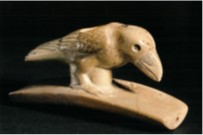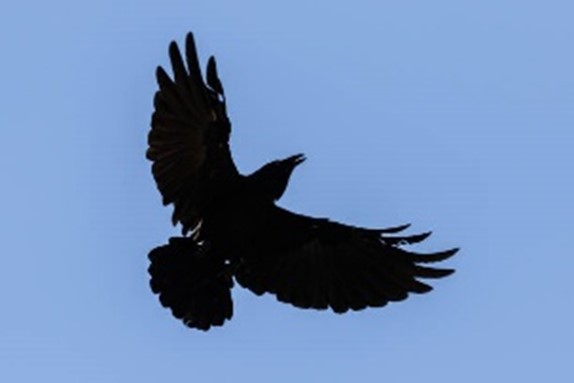
WAA – the Raven[1]
Waa is the Wurundjeri wilan moiety totem. It is the crow, also called the raven.
‘“Caw” says the crow as she flies over head, It’s time little people were going to bed”![2]’
A father sings a lullaby each night – crow as a squawky protector.
The Australian Ravens or Crows are often overlooked birds, but they are an important feature of Australian Indigenous culture.
ALWAYS WAS, ALWAYS WILL BE.
During our lockdown we became increasingly aware of these beautiful birds – in gardens, swinging on pergolas, sweeping canopy to canopy across neighbourhood tall trees. They pecked at fogo recycling bags and pellets of garden mulch. Their drawn out call at first sounded like a complaint. As we listened carefully, it was a conversation – perky, wild and energetic. The ravens seemed to forewarn in a kindly way, without danger. Kruukk she caws. Craw craw. Repeating back and forth across wires, chimneys and tall trees. Sleek black bodies. Light claw steps. Taking shelter in the rain.
Ravens

Birdlife Australia reports little difference between Australian crows and ravens.[3] The Australian raven’s ancestor is likely ~4million years old[4]. Ravens are super intelligent, empathetic, mate for life and, as teenagers, roam around in gangs[5]. Unlike any other wild animals, except primates, ravens can communicate using hand gestures and by holding up objects to get each other’s attention[6]. In captivity, they can learn to talk better than parrots and mimic other noises[7]. They will try to trick each other. If a raven knows it’s being watched by other ravens, it will pretend to put its food in one place whilst secretly hiding it elsewhere. Ravens make their own toys. [8]
Ravens figure large in Greek, Roman, Celtic and Norse Mythology. Legend says the Tower of London may fall if the ravens leave.[9]
American Indian cultural heritage included the raven. Raven pipes and statues are found in archaeological digs dated to 100-400AD. To the People of the Pacific Northwest coast of North America, Raven is the great Creator and also a great rascal[10].

Cocksure smooth talker’ good looker;
Raven makes a name for himself
Up and down the coast from the Nass River;
Stirs things up.
Hurling the first light, it lodges
In the ceiling of the sky,
Everything takes form –
…
Raven turns his head
and laughs in amazement,
then dives off the landscape,
dividing the air
into moment before
and instant after.[11]
A stately raven came to poet Edgar Allen Poe ‘once upon a midnight dreary’. ‘Nevermore’ was all it said:
‘And his eyes have all the seeming of a demon’s that is dreaming, And the lamp-light o’er him streaming throws his shadow on the floor; And my soul from out that shadow that lies floating on the floor; Shall be lifted – nevermore![12]
Local writer, Zana Fraillon, has a cheeky guiding raven in her young adult story:
‘Oh yes, I’m your Guardian. Krruk’s the name and how de do and shake hands and we’ll be home for break-fast.
You won’t remember all those times durin’ your alive years that you saw a raven guidin’ you through the trials and tribulations of livin’.
Here. Have a feather. Raven’s feathers are good luck you know. That should make you happy’[13].
The Raven is fire, central to place, carried from place to place, essential for cooking, warmth and light. It keeps away evil spirits. Newborns are smoked in the ashes. Essential for regeneration of native plants, burning ensured ecological balance and supported animal life. Fire brings transformation and, from the ashes of fire, regeneration.[14]

Waa
So, what of Waa?
According to the great Wurundjeri Elder, William Barak[15]:
‘… (I)f a crow comes overhead and cries, ‘Waa! Waa! Waa!’ we know our enemies are somewhere near. If he calls out overhead like this, and flies away still crying out, ‘Waa!’ then we run after him to escape.’[16]
Waa as a moiety is an Ancestral Being whose spirit passes to descendants[17]. Ancestral Beings came before, and continue to inhere in living generations[18]. They always were and always are.
The Wurundjeri say:
‘From the time we are small, we hear stories about the Dreamtime, when our great Creative Ancestors roamed the earth. … All the people, and plants and animals come from these great powers, and we are still part of them. We each have a totem animal, an animal that we have a special kinship with, because we are still part of the Creative Power who brings that bird or animal into being. We never harm it. If we see our totem animal, or hear it call out, we pay attention.
We pay attention to all the creatures, because they are still one with the Creative Beings who first walked the earth, just as we are. We know they often give us signs about what is happening and what we should do.[19]’
A moiety links land law and spiritual beliefs. It identifies lineage. The Ancestral Beings founded the laws of human society, particularly the principle of reciprocity and responsibilities for land, as well as ceremony, marriage rules and food taboos.[20]
In her wonderful childrens’ books, Wurundjeri Elder, Professor Aunty Joy Wandin AO, William Barak’s descendant, gives recognition to Waa[21]. He’s pictured in Lisa Kennedy’s beautiful illustrations.[22]
‘Waa flies along Birrarung
with his brothers,
making his slow high call,
drawing out the last note
so everyone can hear.’[23]
‘The Dreamtime isn’t ancient history. It’s always here and now. We all come out of the power of the Dreaming, and are still part of it. … When we die, we return to our source, which we have never left. We return to the Dreaming.’[24]
ALWAYS WAS, ALWAYS WILL BE.
Waa and Fire

A story of Waa, told by Larry Walsh a Taunwurrung man, shows his travels across Wurundjeri land[25].
‘At one time, all Kulin ate their food raw and were always sick during winter. There were seven[26] women who never complained about cold and beautiful smells came from their camp. Waa noticed that the women had digging sticks with tops glowing red. The women loved honey ants, but were afraid of snakes. Waa the white Crow watched these women carefully and noticed that the tops of their digging sticks were glowing red.
The women loved honey ants but were afraid of snakes. Waa put some baby snakes inside a hollow log and sealed it up. He told the women that there were honey ants inside and that they should use their digging sticks to break it open. All the snakes shot out and the women started hitting the ground so hard to keep the snakes away that the tops of their digging sticks broke off. Waa took off with them.
The women called out, abusing the Crow and calling him thief. All this noise attracted the attention of Bunjil and the women told Bunjil that Waa had stolen the secret of fire. Bunjil asked his two nephews, Jert Jert and Thara, to chase after Waa and get the sticks back. Waa flew so fast that one of the sticks caught fire and he dropped it at a place called Mooneo in the Dandenongs, the first hill burnt by fire. Thara told Jert Jert to keep going because he was a lot quicker.
Waa then flew so fast that this time all the sticks caught fire, burning Waa and turning him black, and he landed at a place called Narnarthum in the Cathedral Ranges in Taunwurrung Country.’
Waa and the Wind
Crow had charge of the winds. After Bunjil created the mountains, rivers, flora, fauna and laws for humans to live by, he asked Crow to open his bags and let out some wind. Crow opened a bag in which he kept his whirlwinds and created a cyclone which uprooted trees. Bunjil asked for stronger wind. Crow complied and Bunijl and his people were blown upwards into the sky. Bunjil became a star[27].
Dreaming and Waa and the Seven[28] Sisters
Fire was a jealously guarded secret. It was held by the Karatgurk seven sisters[29]. They lived by the Yarra River, where Narm[30] (Melbourne) is located.
The women carried live coals on the ends of their digging sticks and cooked yams. One day Waa found a cooked yam and found it tastier than the raw vegetables he had been eating. But, the Karatgurk sisters refused to share their fire with him.
Crow decided to trick them into giving it up. In some stories, when the women strike the snakes and the live coals fly out, Crow, who is waiting, gathers up the coals and hides them in a kangaroo skin bag. The women discover the theft and chase him, but the bird simply flies out of their reach, perching at the top of a high tree.
Bunjil asked Crow for some of the coals so he could cook a possum. Crow offered to cook it for Bunjil. A large group gathered around Crow’s tree shouting that he share the secret of fire. The din frightened Crow and, at last, he flung several live coals at the crowd. The coals caused a bushfire which threatened to consume the whole land until Bunjil’s efforts halted its spread. The bushfire burnt Crow’s feathers permanently black.
The Karatgurk sisters were swept into the sky where they became the Pleiades (the stars representing their glowing fire sticks.)
WAA: ALWAYS WAS, ALWAYS WILL BE.
A bird created before the Pliocene Age. An Ancestral Being whose spirit passes to those living today. The Raven links land law with spiritual beliefs. A highly intelligent trickster, it is the power of Australia’s Dreaming. We are part of it. When we die, we return to our source that we never left.
ALWAYS WAS, ALWAYS WILL BE.
KELLEHERS AUSTRALIA PTY LTD
10 NOVEMBER 2020
Download a PDF of this Article HERE
Liability limited by a Scheme approved under Professional Standards Legislation
[1] Also known as Wagan, Whan and Waang https://en.wikipedia.org/wiki/Crow_(Australian_Aboriginal_mythology accessed 14082020.
[2] https//nurseryrhymenscollections.com/lyrics/bedtime.html accessed 12082020.
[3] Birdlife Australia records six members of the Australian raven family – Corvus coronoides: Corvidae. Three are called crows and three ravens, although there is very little difference. Most species are similar in size and color and can be difficult to tell apart. They are black with white eyes in adults. They do not flick wings when calling and are usually seen in pairs. Young birds have dark eyes. Populations of Australian Ravens in built-up areas have increased greatly in recent years. The boom is due to refuse generated by a disposable society. The species is sometimes called a crow. www.birdlife.org.au/bird-profile/australian-raven accessed 13082020. Also,Peter Hancock noted that crows breed from mid-July to late August, building bowl-shaped nests of sticks lined with bark and fur, in which they lay four to five pale green eggs, splotched with brown. Hancock, Peter, 2013, Raven the undertaker of the bush, The Sydney Morning Herald, March 22.
[4] Jonsson, Knud A., Pierre-Henri Fabre, Martin Irestedt, 2012, Brains, tools, innovation and biogeography in crows and ravens, BMC Evolutionary Biology, Vol. 12, 72.
[5] Lanzendorfer, Joy, 2016, 10 Fascinating Facts About Ravens, January 7, https://www.mentalfloss.com./article/53295/10-fascinating-facts-about-ravens accessed 12082020, 708.
[6] https://www.google.com.au/amp/s/www.livescience.com/amp/17213-ravens-gestures-animal-communication.html accessed 08112020.
[7] Lanzendorfer, op. cit, 5-6.
[8] https://www.google.com.au/amp/s/www.pinterest.com/amp/pin/513199320012349033 accessed 11082020 and 08112020.
[9] https://www.hrp.org.uk/tower-of-london/whats-on/the-ravens/#gs.l1t9po, accessed 10112020.
[10] Gerald McMaster and Clifford E. Trafzer (eds.), 2004, Native Universe: Voices of Indian America, National Museum of the American Indian, Smithsonian Institution, Washington DC, 39.
[11] Davis, H., Robert (Tlingit), 2009, from Saginaw Bay: I Keep Going Back, Alaskan Quarterly Review, Vol. 26, No. 1 & 2, Spring/Summer, https://aqreview.org/saginaw-bay-i-keep-going-back/, accessed 08112020.
[12] Poe, Edgar Allan, 1845, The Raven, New York Evening Mirror, January 29, https://www.poetryfoundation.org/poems/48860/the-raven accessed 11082020.
[13] Fraillon, Zana, 2020, The Lost Soul Atlas, Hachette Australia, Sydney Australia, 10-11.
[14] Native Symbols, 2014, The Four Elements, https://nativesymbols.info/wp-contents/uploads/2014/09/traditional-owners.jpg accessed 06112020.
[15] William Barak, who attended Batman’s treaty event as a boy, was the son of Billibellary whose mob was the Wurund’jeri willam. Barak’s sister Anne Boorat and her son Robert Wandoon are the forebears of all present day Wurund’jeri descendants.
[16] Nillumbik Reconciliation Group Inc, 2008, Wurundjeri Culture Resource Kit (preview copy), 8, https://nrg.org.au/index_files/resource_kit_preview.pdf, accessed 06112020.
[17] Tripcony, Penny, 1996, Too obvious to see: Explaining the basis of Aboriginal spirituality, 3, conference paper presented to the Australian Association of Religious Educators Conference, Gold Coast, October, qcaa.qld.edu.au/downloads/approach2/indigenous_read001_0708.pdf accessed 06112020.
[18] Tripcony, op. cit, 3.
[19] Nillumbik Reconciliation Group Inc, op. cit., 8.
[20] Tripcony, op. cit., 4.
[21] Murphy, Joy and Andrew Kelly, 2019, Wilam: A Birrarung Story, Black Dog Books an imprint of Walker Boos Australia Pty Ltd, New Town NSW, Australia.
[22] Murphy, 206, Welcome to country, Black Dog Books, Newton NSW, Murphy, and Kelly,op.cit., 14.
[23] Op cit, 14.
[24] Nillumbik Reconciliation Group Inc, op. cit., 9.
[25] https://cv.vic.gov.au/stories/aboriginal-culture/meerreeng-an-here-is-my-country/black-crow/ accessed 11082020
[26] Several sources give five sisters eg Nillumbik Reconciliation Group Inc, op. cit., 9. These derive from Massolo, Aldo, 1968, Bunjil’s Cave: Myths, Legends and Superstitions of the Aborigines of South-East Australia, 52-53.
[27] Mudrooroo, 1994, Aboriginal mythology: An A-Z spanning the history of the Australian Aboriginal people from the earliest legends to the present day, Thorsons, London, Taungurung Land & Waters Council, 2020, Creation Stories, https://taungurung.com.au/creation-stories/ accessed 11082020.
[28] Several sources give five sisters eg Nillumbik Reconciliation Group Inc, op. cit., 9, deriving from Massolo, op.cit.
[29] Mudrooroo, op. cit. 35-36.
[30] Nicholson, Mandy, 2018, Mandy Nicholson – Deadly Story, https://www.deadlystory.com/culture/my-stories/NAIDOC-week/Mandy_Nicholson, accessed 05112020.
Liability limited by a scheme approved under Professional Standards Legislation
This fact sheet is intended only to provide a summary and general overview on matters of interest. It does not constitute legal advice. You should always seek legal and other professional advice which takes account of your individual circumstances.
Leave a Reply